 Space Shuttle Enterprise takes off – on the back of a Boeing 747 – for the last of its “active-captive” flights, with a crew aboard and all systems powered up. For this final test flight prior to the first free-flight landing test mere weeks away, Enterprise is again crewed by astronauts Fred Haise and Gordon Fullerton, and reaches an altitude of 30,000 feet.
Space Shuttle Enterprise takes off – on the back of a Boeing 747 – for the last of its “active-captive” flights, with a crew aboard and all systems powered up. For this final test flight prior to the first free-flight landing test mere weeks away, Enterprise is again crewed by astronauts Fred Haise and Gordon Fullerton, and reaches an altitude of 30,000 feet.

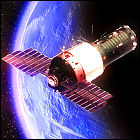 The Soviet-launched Salyut 5 military space station tumbles out of its orbit, having exhausted the fuel needed to keep it in a controlled orbit of the Earth. The two-ton space station burns up on re-entry, having been visited by only two crews; another mission to Salyut 5 had been planned, but its fuel depletion made that flight too risky to undertake.
The Soviet-launched Salyut 5 military space station tumbles out of its orbit, having exhausted the fuel needed to keep it in a controlled orbit of the Earth. The two-ton space station burns up on re-entry, having been visited by only two crews; another mission to Salyut 5 had been planned, but its fuel depletion made that flight too risky to undertake. Released from its 747 Shuttle Carrier Aircraft in mid-air for the first time, and airborne on its own for the first time, the Space Shuttle Enterprise takes wing over the dry lake bed at Edwards Air Force Base for a test landing. With no engines on board (a test shuttle that will never go into orbit, Enterprise isn’t equipped with them) and only one shot at a safe landing, Enterprise successfully touches down on the runway after a flight lasting only a few minutes, validating the unpowered approach method of landing a shuttle just returned from space.
Released from its 747 Shuttle Carrier Aircraft in mid-air for the first time, and airborne on its own for the first time, the Space Shuttle Enterprise takes wing over the dry lake bed at Edwards Air Force Base for a test landing. With no engines on board (a test shuttle that will never go into orbit, Enterprise isn’t equipped with them) and only one shot at a safe landing, Enterprise successfully touches down on the runway after a flight lasting only a few minutes, validating the unpowered approach method of landing a shuttle just returned from space.  The first Space Shuttle external tank, given the designation MPTA-ET (main propulsion test article external tank), is completed at NASA’a Michoud assembly plant in New Orleans. Though constructed to flight specifications (as they stand in 1977), MPTA-ET is not intended for orbital flight, but is instead erected on a test firing stand at a NASA facility in Mississippi for tests of the three-engine shuttle propulsion system, tests which do not produce a satisfactory result until July 1980. Its job completed, MPTA-ET is later put on display at the U.S. Space & Rocket Center in Huntsville, Alabama.
The first Space Shuttle external tank, given the designation MPTA-ET (main propulsion test article external tank), is completed at NASA’a Michoud assembly plant in New Orleans. Though constructed to flight specifications (as they stand in 1977), MPTA-ET is not intended for orbital flight, but is instead erected on a test firing stand at a NASA facility in Mississippi for tests of the three-engine shuttle propulsion system, tests which do not produce a satisfactory result until July 1980. Its job completed, MPTA-ET is later put on display at the U.S. Space & Rocket Center in Huntsville, Alabama.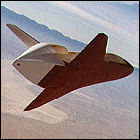 For the second time, the
For the second time, the 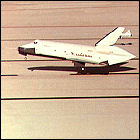 For the third time, Space Shuttle Enterprise separates from the back of a Boeing 747 flying at nearly 25,000 feet above the dry lake bed landing strips at Edwards Air Force Base in California. With astronauts Fred Haise and Gordon Fullerton aboard, Enterprise safely glides to her third safe landing at Edwards. This is the last of the test landings to leave the aerodynamic tail cone over Enterprise’s “anatomically correct” (but nonfunctional) main engines; the remaining Approach & Landing test flights will test the aerodynamics of an orbiter as it would return from space with those engines exposed.
For the third time, Space Shuttle Enterprise separates from the back of a Boeing 747 flying at nearly 25,000 feet above the dry lake bed landing strips at Edwards Air Force Base in California. With astronauts Fred Haise and Gordon Fullerton aboard, Enterprise safely glides to her third safe landing at Edwards. This is the last of the test landings to leave the aerodynamic tail cone over Enterprise’s “anatomically correct” (but nonfunctional) main engines; the remaining Approach & Landing test flights will test the aerodynamics of an orbiter as it would return from space with those engines exposed.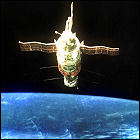 The Soviet Union launches the redesigned Salyut 6 space station, which will remain in service for five years. With six years of experience in building and operating space stations, Soviet space engineers embark on a rethink of station construction, opting for a more modular approach with Salyut 6: the new station has docking ports fore and aft, with additional station modules and automated resupply vehicles already on the drawing board. The dual docking ports also allow for multiple Soyuz capsules to be berthed at Salyut 6, making larger crews possible.
The Soviet Union launches the redesigned Salyut 6 space station, which will remain in service for five years. With six years of experience in building and operating space stations, Soviet space engineers embark on a rethink of station construction, opting for a more modular approach with Salyut 6: the new station has docking ports fore and aft, with additional station modules and automated resupply vehicles already on the drawing board. The dual docking ports also allow for multiple Soyuz capsules to be berthed at Salyut 6, making larger crews possible.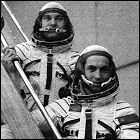 The Soviet Union launches Soyuz 25 into Earth orbit, with cosmonauts Vladimir Kovalyonok and Valery Ryumin set to become the first occupants of the new Salyut 6 space station. However, the crew is unable to successfully dock Soyuz 25 to Salyut 6, and after a fifth attempt to dock, the mission is aborted and the cosmonauts are recalled to Earth due to concerns about the remaining fuel in their vehicle. As a result, Soyuz 25 is the last all-rookie Soviet space crew until the 1990s.
The Soviet Union launches Soyuz 25 into Earth orbit, with cosmonauts Vladimir Kovalyonok and Valery Ryumin set to become the first occupants of the new Salyut 6 space station. However, the crew is unable to successfully dock Soyuz 25 to Salyut 6, and after a fifth attempt to dock, the mission is aborted and the cosmonauts are recalled to Earth due to concerns about the remaining fuel in their vehicle. As a result, Soyuz 25 is the last all-rookie Soviet space crew until the 1990s.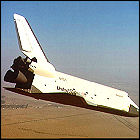 Space Shuttle Enterprise makes its fourth free-flight after separating from its modified Boeing 747 carrier aircraft, gliding to a safe landing at Edwards Air Force Base’s dry lake bed runway. For the first time, Enterprise’s engines are left exposed, adding to the drag experienced by the gliding shuttle rather than masking the engines with a protective cover. This more accurately simulates the aerodynamics of a shuttle returning from space. Enterprise’s crew for the two-and-a-half-minute flight consists of Joe Engle and Richard Truly.
Space Shuttle Enterprise makes its fourth free-flight after separating from its modified Boeing 747 carrier aircraft, gliding to a safe landing at Edwards Air Force Base’s dry lake bed runway. For the first time, Enterprise’s engines are left exposed, adding to the drag experienced by the gliding shuttle rather than masking the engines with a protective cover. This more accurately simulates the aerodynamics of a shuttle returning from space. Enterprise’s crew for the two-and-a-half-minute flight consists of Joe Engle and Richard Truly.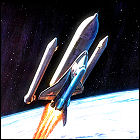 NASA prepares a preliminary schedule of Space Shuttle launches, covering the years 1979-1982 (and assuming the shuttle will be ready to launch in 1979). The ambitious schedule (which also assumes, in line with current planning, that the test orbiter Enterprise will be upgraded to spaceworthiness) includes almost-monthly flights from 1979 onward to deploy communications and weather satellites already on the drawing board, as well as frequent science missions with the cargo-bay-mounted Spacelab. On only the second test flight, the schedule has OV-102 (yet to be named Columbia) slated for a mission to the abandoned early 1970s space station Skylab, using a teleoperator retrieval system which also exists only on paper. While many of the schedule’s goals will be met, the delay in the shuttle program will be longer than NASA anticipates at this time.
NASA prepares a preliminary schedule of Space Shuttle launches, covering the years 1979-1982 (and assuming the shuttle will be ready to launch in 1979). The ambitious schedule (which also assumes, in line with current planning, that the test orbiter Enterprise will be upgraded to spaceworthiness) includes almost-monthly flights from 1979 onward to deploy communications and weather satellites already on the drawing board, as well as frequent science missions with the cargo-bay-mounted Spacelab. On only the second test flight, the schedule has OV-102 (yet to be named Columbia) slated for a mission to the abandoned early 1970s space station Skylab, using a teleoperator retrieval system which also exists only on paper. While many of the schedule’s goals will be met, the delay in the shuttle program will be longer than NASA anticipates at this time. Astronauts Fred Haise and Gordon Fullerton bring Space Shuttle Enterprise back to the ground safely for its fifth free-flight landing test, the second to land with the shuttle’s engines exposed and the first to land on an actual paved runway at Edwards Air Force Base. The crew successfully compensates for a “bouncing” problem experienced on previous shuttle test landings, proving that Enterprise’s sister ships should be able to land safely after returning from orbit. Following this test, Enterprise is slated to undergo a major refit to finish it out into a spaceworthy orbiter, but NASA ultimately decides the process is too expensive. This is the final free-flight of Space Shuttle Enterprise.
Astronauts Fred Haise and Gordon Fullerton bring Space Shuttle Enterprise back to the ground safely for its fifth free-flight landing test, the second to land with the shuttle’s engines exposed and the first to land on an actual paved runway at Edwards Air Force Base. The crew successfully compensates for a “bouncing” problem experienced on previous shuttle test landings, proving that Enterprise’s sister ships should be able to land safely after returning from orbit. Following this test, Enterprise is slated to undergo a major refit to finish it out into a spaceworthy orbiter, but NASA ultimately decides the process is too expensive. This is the final free-flight of Space Shuttle Enterprise.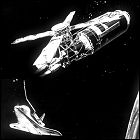 NASA and its contractors mull over a report outlining an ambitious (and, considering the continuous delays to the first launch of the Space Shuttle program, overly optimistic) plan to reactivate and occupy the Apollo-era space station Skylab for use by shuttle crews. The plan involves outfitting the ailing station with new solar power panels and equipment, and performing repairs to make it habitable for future astronauts. Despite the best-laid plans, however, the shuttle’s first launch comes after Skylab tumbles back through Earth’s atmosphere.
NASA and its contractors mull over a report outlining an ambitious (and, considering the continuous delays to the first launch of the Space Shuttle program, overly optimistic) plan to reactivate and occupy the Apollo-era space station Skylab for use by shuttle crews. The plan involves outfitting the ailing station with new solar power panels and equipment, and performing repairs to make it habitable for future astronauts. Despite the best-laid plans, however, the shuttle’s first launch comes after Skylab tumbles back through Earth’s atmosphere.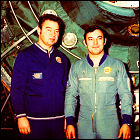 A two-man crew – cosmonauts Yuri Romanenko and Georgi Grechko – is launched aboard Soyuz 26 by the Soviet Union. The Soyuz capsule docks with the recently-launched Salyut 6 space station, and the crew takes up residence for over three months, setting a new space endurance record at 96 days. The Soyuz 27 crew visits in January and swaps vehicles with the station occupants, meaning that Romanenko and Grechko technically return to Earth aboard Soyuz 27 in March 1978. Ten days into the mission, the first Soviet spacewalk since 1969 is undertaken to examine the forward docking hatch of Salyut 6, with which the previous mission failed to connect. This spacewalk was the first outing of the Soviet-made Orlan spacesuit, a design still in use on the International Space Station in the 21st century.
A two-man crew – cosmonauts Yuri Romanenko and Georgi Grechko – is launched aboard Soyuz 26 by the Soviet Union. The Soyuz capsule docks with the recently-launched Salyut 6 space station, and the crew takes up residence for over three months, setting a new space endurance record at 96 days. The Soyuz 27 crew visits in January and swaps vehicles with the station occupants, meaning that Romanenko and Grechko technically return to Earth aboard Soyuz 27 in March 1978. Ten days into the mission, the first Soviet spacewalk since 1969 is undertaken to examine the forward docking hatch of Salyut 6, with which the previous mission failed to connect. This spacewalk was the first outing of the Soviet-made Orlan spacesuit, a design still in use on the International Space Station in the 21st century.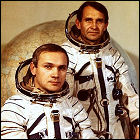 The Soviet Union launches Soyuz 27 on a mission to the Salyut 6 space station – the first instance of three vehicles being docked together in space. Cosmonauts Vladimir Dzhanibekov and Oleg Makarov spend six days with the crew of Soyuz 26 board the station, although Dzhanibekov and Makarov swap capsules with the station crew, leaving the newer vehicle at the station for their eventual return. The crew of Soyuz 27 is in space for less than a week, but their spacecraft remains in orbit, connected to Salyut, for over two months.
The Soviet Union launches Soyuz 27 on a mission to the Salyut 6 space station – the first instance of three vehicles being docked together in space. Cosmonauts Vladimir Dzhanibekov and Oleg Makarov spend six days with the crew of Soyuz 26 board the station, although Dzhanibekov and Makarov swap capsules with the station crew, leaving the newer vehicle at the station for their eventual return. The crew of Soyuz 27 is in space for less than a week, but their spacecraft remains in orbit, connected to Salyut, for over two months.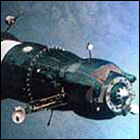 The first Soviet-made uncrewed Progress resupply vehicle lifts off en route to the manned Salyut 6 space station. Looking more or less like a Soyuz vehicle, Progress is an automated freighter whose systems lock onto Salyut’s docking transponder, guiding the unmanned craft toward a smooth and completely automated docking (though ground controllers stand by to take manual control by remote). Since Progress is not required to return a crew to Earth, its engines and their fuel can help to boost Salyut 6 into a higher orbit when necessary. It carries over 5,000 pounds of food, clothes and other supplies, and can automatically refill the station’s air and fuel supplies. Progress vehicles become an integral part of the space program, remaining in service long enough to resupply the International Space Station in the 21st century.
The first Soviet-made uncrewed Progress resupply vehicle lifts off en route to the manned Salyut 6 space station. Looking more or less like a Soyuz vehicle, Progress is an automated freighter whose systems lock onto Salyut’s docking transponder, guiding the unmanned craft toward a smooth and completely automated docking (though ground controllers stand by to take manual control by remote). Since Progress is not required to return a crew to Earth, its engines and their fuel can help to boost Salyut 6 into a higher orbit when necessary. It carries over 5,000 pounds of food, clothes and other supplies, and can automatically refill the station’s air and fuel supplies. Progress vehicles become an integral part of the space program, remaining in service long enough to resupply the International Space Station in the 21st century.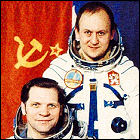 The Soviet Union launches the Soyuz 28 mission, the first manned flight in its Interkosmos series of international space missions. Cosmonaut Vladimír Remek is the first Czech in space, as well as the first space traveler not born in the Soviet Union or the United States; along with Soyuz 28 mission commander Alexei Gubarev, Remek visits the Salyut 6 space station for several days, though is presence is purely political showmanship; Remek later reveals that he had few actual functions to perform during the flight. Soyuz 28 spends a total of nearly eight days in space before returning to Earth.
The Soviet Union launches the Soyuz 28 mission, the first manned flight in its Interkosmos series of international space missions. Cosmonaut Vladimír Remek is the first Czech in space, as well as the first space traveler not born in the Soviet Union or the United States; along with Soyuz 28 mission commander Alexei Gubarev, Remek visits the Salyut 6 space station for several days, though is presence is purely political showmanship; Remek later reveals that he had few actual functions to perform during the flight. Soyuz 28 spends a total of nearly eight days in space before returning to Earth.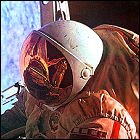 The Soviet Union launches Soyuz 29 on a mission to berth at space station Salyut 6 for a period of around four months. Cosmonauts Vladimir Kovalyonok and Aleksandr Ivanchenkov are aboard, and they eventually set a new space endurance record, remaining in orbit for 139 days. Numerous material science experiments are carried out, as well as a spacewalk to retrieve samples of various materials left exposed to space outside the station. The crew is also assigned to take on a more rigorous exercise program. They will return to Earth in November after swapping vehicles with the crew of Soyuz 31.
The Soviet Union launches Soyuz 29 on a mission to berth at space station Salyut 6 for a period of around four months. Cosmonauts Vladimir Kovalyonok and Aleksandr Ivanchenkov are aboard, and they eventually set a new space endurance record, remaining in orbit for 139 days. Numerous material science experiments are carried out, as well as a spacewalk to retrieve samples of various materials left exposed to space outside the station. The crew is also assigned to take on a more rigorous exercise program. They will return to Earth in November after swapping vehicles with the crew of Soyuz 31.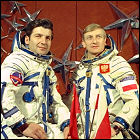 Soyuz 30 lifts off en route to a brief visit with the crew of space station Salyut 6. This is the second manned Interkosmos mission, with cosmonaut Pyotr Klimuk and the first Polish cosmonaut, Mirosław Hermaszewski, aboard. They dock at Salyut 6 after two days in orbit, and spend a total of eight days in space. Though some joint experiments are conducted among the four occupants of the station, the Soyuz 30 crew frequently has to perform experiments in its own Soyuz vehicle to avoid getting in the station crew’s way, and the mission is kept short to free up the second docking port for a Progress unmanned supply vehicle launched four days after Soyuz 30 returns to Earth.
Soyuz 30 lifts off en route to a brief visit with the crew of space station Salyut 6. This is the second manned Interkosmos mission, with cosmonaut Pyotr Klimuk and the first Polish cosmonaut, Mirosław Hermaszewski, aboard. They dock at Salyut 6 after two days in orbit, and spend a total of eight days in space. Though some joint experiments are conducted among the four occupants of the station, the Soyuz 30 crew frequently has to perform experiments in its own Soyuz vehicle to avoid getting in the station crew’s way, and the mission is kept short to free up the second docking port for a Progress unmanned supply vehicle launched four days after Soyuz 30 returns to Earth. The Soviet Union’s Soyuz 31 mission to the Salyut 6 space station lifts off, with cosmonauts Valery Bykovsky and Sigmund Jahn (the first East German space traveler) aboard. The crews are segregated less than on previous Interkosmos flights, and the Soyuz 31 crew is in space for over a week. They leave their vehicle at Salyut 6 and return in the Soyuz 29 vehicle on September 3rd.
The Soviet Union’s Soyuz 31 mission to the Salyut 6 space station lifts off, with cosmonauts Valery Bykovsky and Sigmund Jahn (the first East German space traveler) aboard. The crews are segregated less than on previous Interkosmos flights, and the Soyuz 31 crew is in space for over a week. They leave their vehicle at Salyut 6 and return in the Soyuz 29 vehicle on September 3rd.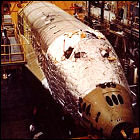 With a newly-awarded NASA contract in hand, Rockwell International begins the process of converting Space Shuttle Structural Test Article 099 into the Orbiter Vehicle 099, later to be christened Space Shuttle Challenger. A process originally envisioned for the test vehicle Enterprise, it is deemed more cost-effective and faster to upgrade STA-099 into OV-099. The first order of business is the construction of a new crew module, since the corresponding section of STA-099 was never actually intended to house human beings.
With a newly-awarded NASA contract in hand, Rockwell International begins the process of converting Space Shuttle Structural Test Article 099 into the Orbiter Vehicle 099, later to be christened Space Shuttle Challenger. A process originally envisioned for the test vehicle Enterprise, it is deemed more cost-effective and faster to upgrade STA-099 into OV-099. The first order of business is the construction of a new crew module, since the corresponding section of STA-099 was never actually intended to house human beings. After several years of referring to the various Space Shuttle orbiters both under construction and in planning by numbers, NASA bestows names upon the anticipated fleet of four orbiters. OV-102, which is still expected to fly “late this year”, is named Columbia, while OV-099, undergoing conversion from a test article to flight-worthy vehicle, is named Challenger. Orbiters 103 and 104 will be named, respectively, Discovery and Atlantis; all four names are drawn from historical seafaring exploration vessels. (NASA has also used some of the names before: Columbia was the name of the moon-orbiting command module in the Apollo 11 mission, while Apollo 17’s lunar lander was named Challenger.)
After several years of referring to the various Space Shuttle orbiters both under construction and in planning by numbers, NASA bestows names upon the anticipated fleet of four orbiters. OV-102, which is still expected to fly “late this year”, is named Columbia, while OV-099, undergoing conversion from a test article to flight-worthy vehicle, is named Challenger. Orbiters 103 and 104 will be named, respectively, Discovery and Atlantis; all four names are drawn from historical seafaring exploration vessels. (NASA has also used some of the names before: Columbia was the name of the moon-orbiting command module in the Apollo 11 mission, while Apollo 17’s lunar lander was named Challenger.)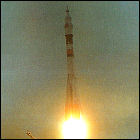 The Soviet Union launches Soyuz 32 on a long-duration mission to space station Salyut 6, with cosmonauts Vladimir Lyakhov and Valery Ryumin aboard. Over a record-setting 175 days, the new station crew conducts necessary repairs and upgrades to the station’s hardware, as well as conducting various experiments. With the arrival of equipment sent in the unmanned Progress 5 freighter in March, this is the first space crew to have a means to see ground controllers via a video link, rather than talking to them via radio; the cosmonauts also look forward to seeing family members during planned teleconferences. This is also the first crew to vacation in space, permitted a five-day break over May Day. Due to a major technical problem in the next manned Soyuz flight, the crew of Salyut 7 sets its duration record without a single visit from another cosmonaut.
The Soviet Union launches Soyuz 32 on a long-duration mission to space station Salyut 6, with cosmonauts Vladimir Lyakhov and Valery Ryumin aboard. Over a record-setting 175 days, the new station crew conducts necessary repairs and upgrades to the station’s hardware, as well as conducting various experiments. With the arrival of equipment sent in the unmanned Progress 5 freighter in March, this is the first space crew to have a means to see ground controllers via a video link, rather than talking to them via radio; the cosmonauts also look forward to seeing family members during planned teleconferences. This is also the first crew to vacation in space, permitted a five-day break over May Day. Due to a major technical problem in the next manned Soyuz flight, the crew of Salyut 7 sets its duration record without a single visit from another cosmonaut. Space Shuttle Columbia is officially rolled out of the Rockwell International construction facility in Palmdale, California, even though her outer “skin” is still unfinished – NASA technicians continue working on perfecting the first spaceworthy shuttle’s thermal tiles for much of the next year, delaying the first launch until sometime in 1981 (just another in a series of delays for a vehicle that had been intended to fly as early as 1977).
Space Shuttle Columbia is officially rolled out of the Rockwell International construction facility in Palmdale, California, even though her outer “skin” is still unfinished – NASA technicians continue working on perfecting the first spaceworthy shuttle’s thermal tiles for much of the next year, delaying the first launch until sometime in 1981 (just another in a series of delays for a vehicle that had been intended to fly as early as 1977).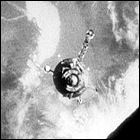 The Soviet Union launches Soyuz 33, intended to take cosmonauts Nikolai Rukavishnikov and Georgi Ivanov (the latter of whom is the first Bulgarian space traveler) to space station Salyut 6. But Soyuz 33 never reaches its destination. At a distance of 3,000 feet from Salyut, Soyuz 33’s main engine fails to fire – the first time such a failure has ever occurred in over a decade of Soyuz flights. Soyuz 33 is recalled to Earth at the earliest opportunity, leaving the station crew with no visits from any other human beings during their two-man, 175-day stay in orbit. It is later discovered that Soyuz 33’s engine could have exploded, causing critical damage to the entire vehicle – and ground controllers now focus their attention on Soyuz 32, docked at Salyut with an engine of identical design which could also fail.
The Soviet Union launches Soyuz 33, intended to take cosmonauts Nikolai Rukavishnikov and Georgi Ivanov (the latter of whom is the first Bulgarian space traveler) to space station Salyut 6. But Soyuz 33 never reaches its destination. At a distance of 3,000 feet from Salyut, Soyuz 33’s main engine fails to fire – the first time such a failure has ever occurred in over a decade of Soyuz flights. Soyuz 33 is recalled to Earth at the earliest opportunity, leaving the station crew with no visits from any other human beings during their two-man, 175-day stay in orbit. It is later discovered that Soyuz 33’s engine could have exploded, causing critical damage to the entire vehicle – and ground controllers now focus their attention on Soyuz 32, docked at Salyut with an engine of identical design which could also fail.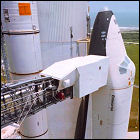 The Space Shuttle Enterprise, a full-sized, full-weight test article not intended for orbital flight, is mated to an external tank and a pair of solid rocket boosters and rolled out to Launch Complex 39A at Cape Canaveral for engineering fit-checks of the redesigned launch pad (a hand-me-down from the Apollo era, where the same pad had launched all but one of the Saturn V rockets). Enterprise remains on the pad for over a month, providing the first photo opportunity of the full-size shuttle launch stack in all of its glory.
The Space Shuttle Enterprise, a full-sized, full-weight test article not intended for orbital flight, is mated to an external tank and a pair of solid rocket boosters and rolled out to Launch Complex 39A at Cape Canaveral for engineering fit-checks of the redesigned launch pad (a hand-me-down from the Apollo era, where the same pad had launched all but one of the Saturn V rockets). Enterprise remains on the pad for over a month, providing the first photo opportunity of the full-size shuttle launch stack in all of its glory.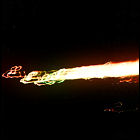 After intense solar activity results in a brief swelling of Earth’s atmosphere,
After intense solar activity results in a brief swelling of Earth’s atmosphere, 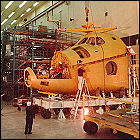 With NASA anticipating ramping up its launch schedule to more than one shuttle flight per month to meet demand for the vehicle’s unique satellite deployment and retrieval capabilities, construction begins on the third orbiter intended for spaceflight, Space Shuttle Discovery. Construction and checking of the third shuttle takes almost exactly four years, with Discovery’s first liftoff about a year later.
With NASA anticipating ramping up its launch schedule to more than one shuttle flight per month to meet demand for the vehicle’s unique satellite deployment and retrieval capabilities, construction begins on the third orbiter intended for spaceflight, Space Shuttle Discovery. Construction and checking of the third shuttle takes almost exactly four years, with Discovery’s first liftoff about a year later. Construction begins on what is intended to be the fourth and final member of the current Space Shuttle fleet, Atlantis. With four orbiters in service, NASA will be one step closer to the routine, almost-weekly schedule of orbital flights envisioned in the Nixon-era mandate for the shuttle. Refinements and improvements in the process of constructing the shuttle fleet make Atlantis the lightest shuttle to date, over three tons lighter than Columbia.
Construction begins on what is intended to be the fourth and final member of the current Space Shuttle fleet, Atlantis. With four orbiters in service, NASA will be one step closer to the routine, almost-weekly schedule of orbital flights envisioned in the Nixon-era mandate for the shuttle. Refinements and improvements in the process of constructing the shuttle fleet make Atlantis the lightest shuttle to date, over three tons lighter than Columbia.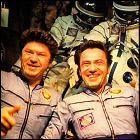 The Soviet Union launches Soyuz 35 en route to space station Salyut 6 for a long-duration stay. Cosmonauts Leonid Popov and Valery Ryumin set a new space endurance record with their 185-day stay, lasting until October 1980. Ryumin had been a member of the last Salyut 6 crew as well, having stayed on the station for six months in 1979, and was not originally scheduled for this mission, rotated into the prime crew due to the illness of the originally assigned crew member. Four other crews visit Salyut 6 during the Soyuz 35 crew’s stay. By the end of this mission, Ryumin holds a personal record for the most time accrued in space by a human being – 352 days, barely two weeks short of a full year of spaceflight experience.
The Soviet Union launches Soyuz 35 en route to space station Salyut 6 for a long-duration stay. Cosmonauts Leonid Popov and Valery Ryumin set a new space endurance record with their 185-day stay, lasting until October 1980. Ryumin had been a member of the last Salyut 6 crew as well, having stayed on the station for six months in 1979, and was not originally scheduled for this mission, rotated into the prime crew due to the illness of the originally assigned crew member. Four other crews visit Salyut 6 during the Soyuz 35 crew’s stay. By the end of this mission, Ryumin holds a personal record for the most time accrued in space by a human being – 352 days, barely two weeks short of a full year of spaceflight experience.